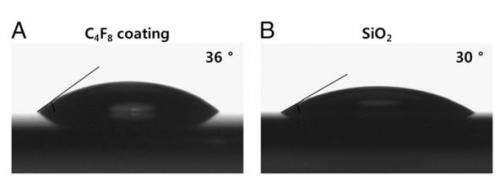November 1, 2012 report
Fireflies give Korean team bright idea for LED lighting

(Phys.org)—Scientists are doing it all the time, attempting to mimic systems and structures of plants and animals to manufacture something entirely new. A group of South Korean scientists have collaborated to translate what they observed in fireflies over toward a better, less expensive, LED lens. Their work is essentially mimicking a bioluminescent organ for lighting applications Following the contemporary practice of investigating biological systems, the team attempted to copy the structure of a firefly's underbelly into work that may lead to more efficient and cheaper LED lighting. They wrote about a better anti-reflective lens for light-emitting diodes (LED) in their paper, "Biologically inspired LED lens from cuticular nanostructures of firefly," which was recently published in Proceedings of the National Academy of Sciences.
A bioluminescent organ such as a firefly lantern uses its bioluminescence to attract a mate. They studied how the lantern layers work to allow for light, paying attention to the firefly lantern's intricate structure. They used a scanning electron microscope and numerical analysis. Further spectroscopic experiments revealed the highly ordered structure reduces optical impedance between air and the cuticle, acting as an anti-reflective layer that cuts the loss of light and raises efficiency. In turn, they created an artificial version for use as a high-power LED lens.
"The nanostructures on an LED lens surface were fabricated by using a large-area nanotemplating and reconfigurable nanomolding with heat-induced shear thinning. The biologically inspired LED lens, distinct from a smooth surface lens, substantially increases light transmission over visible ranges, comparable to conventional antireflection coating. This biological inspiration can offer new opportunities for increasing the light extraction efficiency of high-power LED packages," they wrote.
They noted that the conventional anti-reflection coating of existing LED lights is an expensive process. They said that conventional polymer lenses for LEDs are made by injection molding and then adding an antireflective coating with sputtering. Their method differed. They found that they could produce an anti-reflective plastic lens with just a single-step injection molding process. They said doing so meant driving down the cost of efficient LEDs. Their LED lens was made using a polyurethane-based optical resin.
The authors of the study are from the Korea Advanced Institute of Science and Technology, Firefly Institute, Korea Basic Science Institute, and Korea Research Institute of Standards and Science.
More information: Biologically inspired LED lens from cuticular nanostructures of firefly lantern, PNAS, Published online before print October 29, 2012, doi: 10.1073/pnas.1213331109
Abstract
Cuticular nanostructures found in insects effectively manage light for light polarization, structural color, or optical index matching within an ultrathin natural scale. These nanostructures are mainly dedicated to manage incoming light and recently inspired many imaging and display applications. A bioluminescent organ, such as a firefly lantern, helps to out-couple light from the body in a highly efficient fashion for delivering strong optical signals in sexual communication. However, the cuticular nanostructures, except the light-producing reactions, have not been well investigated for physical principles and engineering biomimetics. Here we report a unique observation of high-transmission nanostructures on a firefly lantern and its biological inspiration for highly efficient LED illumination. Both numerical and experimental results clearly reveal high transmission through the nanostructures inspired from the lantern cuticle. The nanostructures on an LED lens surface were fabricated by using a large-area nanotemplating and reconfigurable nanomolding with heat-induced shear thinning. The biologically inspired LED lens, distinct from a smooth surface lens, substantially increases light transmission over visible ranges, comparable to conventional antireflection coating. This biological inspiration can offer new opportunities for increasing the light extraction efficiency of high-power LED packages.
Journal information: Proceedings of the National Academy of Sciences
© 2012 Phys.org




















